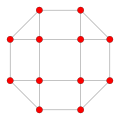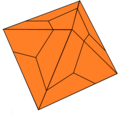Deltoidal icositetrahedron
| Deltoidal icositetrahedron | |
|---|---|
 (Click here for rotating model) | |
| Type | Catalan |
| Conway notation | oC or deC |
| Coxeter diagram | |
| Face polygon |  kite |
| Faces | 24 |
| Edges | 48 |
| Vertices | 26 = 6 + 8 + 12 |
| Face configuration | V3.4.4.4 |
| Symmetry group | Oh, BC3, [4,3], *432 |
| Rotation group | O, [4,3]+, (432) |
| Dihedral angle | 138°07′05″ arccos(−7 + 4√2/17) |
| Dual polyhedron | rhombicuboctahedron |
| Properties | convex, face-transitive |
 Net | |

In geometry, a deltoidal icositetrahedron (also a trapezoidal icositetrahedron, tetragonal icosikaitetrahedron,[1], tetragonal trisoctahedron[2] and strombic icositetrahedron) is a Catalan solid. Its dual polyhedron is the rhombicuboctahedron.
Cartesian coordinates
Cartesian coordinates for a suitably sized deltoidal icositetrahedron centered at the origin are:
- (±1, 0, 0), (0, ±1, 0), (0, 0, ±1)
- (0, ±1/2√2, ±1/2√2), (±1/2√2, 0, ±1/2√2), (±1/2√2, ±1/2√2, 0)
- (±(2√2+1)/7, ±(2√2+1)/7, ±(2√2+1)/7)
The long edges of this deltoidal icosahedron have length √(2-√2) ≈ 0.765367.
Dimensions
The 24 faces are kites[3]. The short and long edges of each kite are in the ratio 1:(2 − 1/√2) ≈ 1:1.292893... If its smallest edges have length a, its surface area and volume are
The kites have three equal acute angles with value and one obtuse angle (between the short edges) with value .
Occurrences in nature and culture
The deltoidal icositetrahedron is a crystal habit often formed by the mineral analcime and occasionally garnet. The shape is often called a trapezohedron in mineral contexts, although in solid geometry that name has another meaning.
Orthogonal projections
The deltoidal icositetrahedron has three symmetry positions, all centered on vertices:
| Projective symmetry |
[2] | [4] | [6] |
|---|---|---|---|
| Image | 
|

|

|
| Dual image |

|

|

|
Related polyhedra
The great triakis octahedron is a stellation of the deltoidal icositetrahedron.
Dyakis dodecahedron

The deltoidal icositetrahedron is topologically equivalent to a cube whose faces are divided in quadrants. It can also be projected onto a regular octahedron, with kite faces, or more general quadrilaterals with pyritohedral symmetry. In Conway polyhedron notation, they represent an ortho operation to a cube or octahedron.
In crystallography a rotational variation is called a dyakis dodecahedron[4][5] or diploid.[6]
| Octahedral, Oh, order 24 | Pyritohedral, Th, order 12 | |||
|---|---|---|---|---|

|

|

|

|

|
Related polyhedra and tilings

The deltoidal icositetrahedron is one of a family of duals to the uniform polyhedra related to the cube and regular octahedron.
When projected onto a sphere (see right), it can be seen that the edges make up the edges of an octahedron and cube arranged in their dual positions. It can also be seen that the threefold corners and the fourfold corners can be made to have the same distance to the center. In that case the resulting icositetrahedron will no longer have a rhombicuboctahedron for a dual, since for the rhombicuboctahedron the centers of its squares and its triangles are at different distances from the center.
| Uniform octahedral polyhedra | ||||||||||
|---|---|---|---|---|---|---|---|---|---|---|
| Symmetry: [4,3], (*432) | [4,3]+ (432) |
[1+,4,3] = [3,3] (*332) |
[3+,4] (3*2) | |||||||
| {4,3} | t{4,3} | r{4,3} r{31,1} |
t{3,4} t{31,1} |
{3,4} {31,1} |
rr{4,3} s2{3,4} |
tr{4,3} | sr{4,3} | h{4,3} {3,3} |
h2{4,3} t{3,3} |
s{3,4} s{31,1} |
= |
= |
= |
||||||||
| Duals to uniform polyhedra | ||||||||||
| V43 | V3.82 | V(3.4)2 | V4.62 | V34 | V3.43 | V4.6.8 | V34.4 | V33 | V3.62 | V35 |
This polyhedron is topologically related as a part of sequence of deltoidal polyhedra with face figure (V3.4.n.4), and continues as tilings of the hyperbolic plane. These face-transitive figures have (*n32) reflectional symmetry.
| Symmetry *n32 [n,3] |
Spherical | Euclid. | Compact hyperb. | Paraco. | ||||
|---|---|---|---|---|---|---|---|---|
| *232 [2,3] |
*332 [3,3] |
*432 [4,3] |
*532 [5,3] |
*632 [6,3] |
*732 [7,3] |
*832 [8,3]... |
*∞32 [∞,3] | |
| Figure Config. |
 V3.4.2.4 |
 V3.4.3.4 |
 V3.4.4.4 |
 V3.4.5.4 |
 V3.4.6.4 |
 V3.4.7.4 |
 V3.4.8.4 |
 V3.4.∞.4 |
See also
- Deltoidal hexecontahedron
- Tetrakis hexahedron, another 24-face Catalan solid which looks a bit like an overinflated cube.
- "The Haunter of the Dark", a story by H.P. Lovecraft, whose plot involves this figure
- Pseudo-deltoidal icositetrahedron
References
- ^ Conway, Symmetries of Things, p.284–286
- ^ https://etc.usf.edu/clipart/keyword/forms
- ^ "Kite". Retrieved 6 October 2019.
- ^ Isohedron 24k
- ^ The Isometric Crystal System
- ^ The 48 Special Crystal Forms
- Williams, Robert (1979). The Geometrical Foundation of Natural Structure: A Source Book of Design. Dover Publications, Inc. ISBN 0-486-23729-X. (Section 3-9)
- Wenninger, Magnus (1983), Dual Models, Cambridge University Press, doi:10.1017/CBO9780511569371, ISBN 978-0-521-54325-5, MR 0730208 (The thirteen semiregular convex polyhedra and their duals, Page 23, Deltoidal icositetrahedron)
- The Symmetries of Things 2008, John H. Conway, Heidi Burgiel, Chaim Goodman-Strass, ISBN 978-1-56881-220-5 [1] (Chapter 21, Naming the Archimedean and Catalan polyhedra and tilings, page 286, tetragonal icosikaitetrahedron)
External links
- Weisstein, Eric W., "Deltoidal icositetrahedron" ("Catalan solid") at MathWorld.
- Deltoidal (Trapezoidal) Icositetrahedron – Interactive Polyhedron model



















































